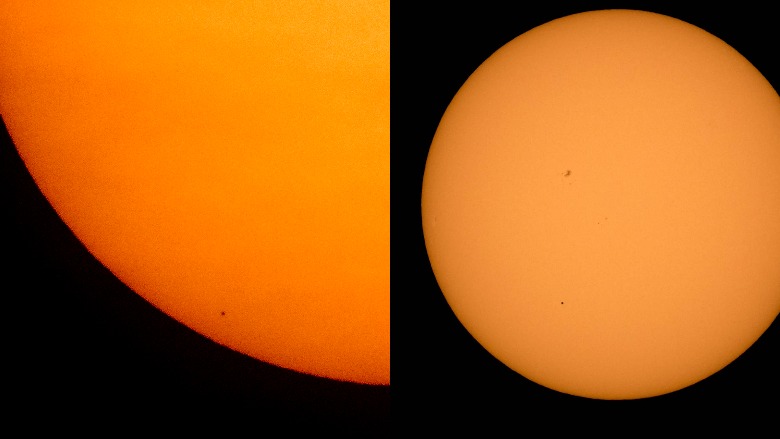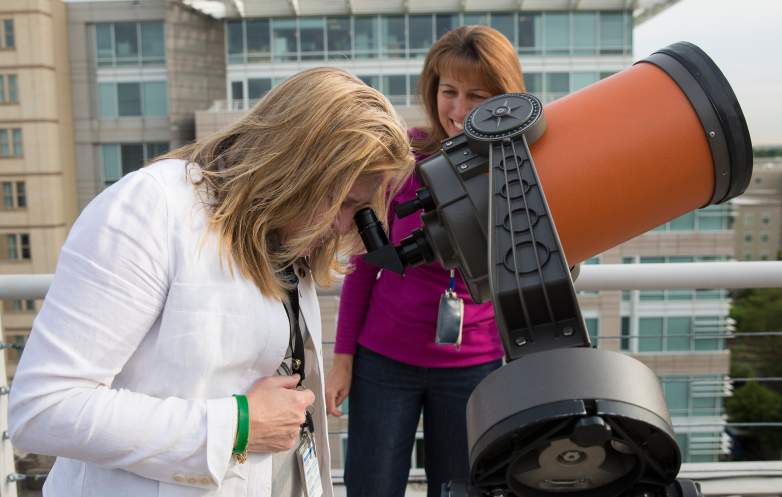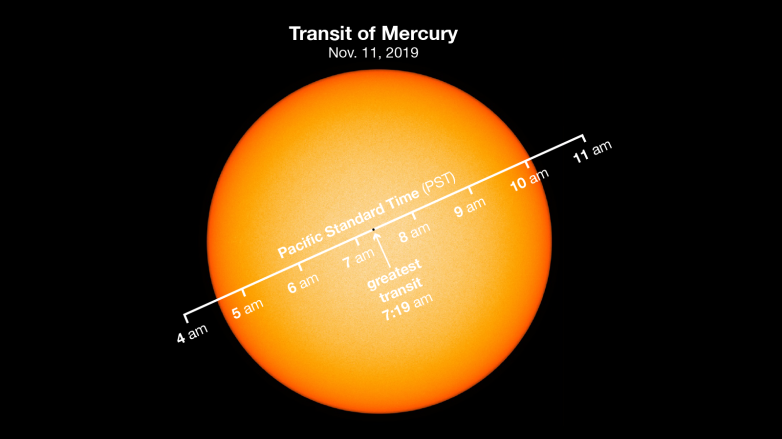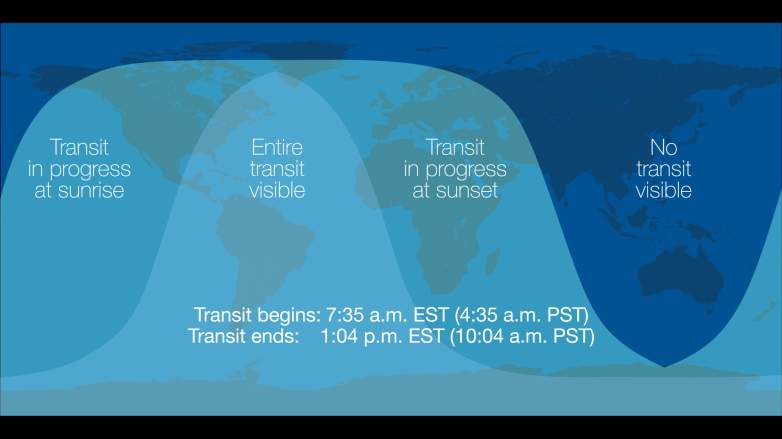
NASA Photos of Mercury in transit from NASA.
Mercury is in transit across the face of the sun on Monday, November 11, 2019. NASA and other satellites are providing live video streams and images of the planet as it is in transit.
“For the next few hours, Mercury will pass between the Earth & the Sun, silhouetting it against our home star,” NASA tweeted. The transit views began at 7 a.m. Eastern and will end at 1:45 p.m. Eastern.
“A transit happens when a planet crosses in front of a star. From our perspective on Earth, we only ever see two planets transit the Sun: Mercury and Venus,” NASA explains. “This is because these are the only planets between us and the Sun. (Transits of Venus are especially rare. The next one won’t happen until 2117.) During the upcoming transit of Mercury, viewers around Earth (using the proper safety equipment) will be able to see a tiny dark spot moving slowly across the disk of the Sun.”
NASA is also sharing near-live images from the Solar Dynamics Observatory.
Here are live streams of mercury in transit:
Watch Mercury in Transit Live Online
If you aren’t able to get outside to watch mercury in transit using the proper equipment, several live streams have been set up around the world from observatories and other locations to show the celestial dance. Here are a few streams:
Lowell Observatory:
“See the 2019 transit of Mercury from the comfort of your home beginning at 7am MST on November 11, when Lowell Observatory live streams a feed from a solar telescope at our newly opened Giovale Open Deck Observatory,” the Lowell Observatory says.
Space Videos:
Space Videos will be providing live-streamed images from NASA.
CosmoSapiens:
Griffith Observatory:
“Mercury will pass in front of the sun on the morning of November 11, 2019. View the transit safely from the comfort of your computer and join us live from Griffith Observatory. NEVER look at the sun directly without proper eye protection,” the Griffith Observatory says. “All Space Considered is Griffith Observatory’s live science program that is free and open to the public, held the first Friday of every month.”
Slooh:
“Slooh will train its highly specialized Solar Telescope, based at its flagship observatory at the Institute of Astrophysics of the Canary Islands, on the tiny planet Mercury as it crosses the face of the Sun,” Slooh says. “Join Slooh host, Paul Cox and Slooh’s experts Bob Berman, Dr Mike Shaw, and special guests who will tell us everything there is to know about Mercury, the Sun, and planetary transits. The team will be discussing the phenomena as viewers snap their own images from the live streams. They will also discuss the importance of planetary transits in history and why major expeditions to view them were organized at great expense during the 1700s.”
PBS NewsHour
P&K SpaceImaging
“Paul and I stream the moon to the world to help educate and give people a rare look at the moon that they may have never seen and to look for anomalies that otherwise would not be seen. We would be doing this whether we have 1 viewer or 1 million viewers. We do this as a service to those who, like us, are natural explorers and want to learn and converse about Earth’s only natural satellite… Luna A.K.A The Moon,” P&K SpaceImaging says.
Here’s How to Watch Mercury Transit Outside

In this handout provided by NASA, NASA Chief Scientist Ellen Stofan looks through a telescope with a solar filter to see the planet Mercury as it transits across the face of the sun as Kelly Fast of NASA’s Science Mission Directorate looks on at NASA Headquarters on May 9, 2016 in Washington, DC.
Mercury in transit can also be seen from the ground using the proper equipment, NASA says. “Looking at the Sun directly or through a telescope without proper protection can lead to serious and permanent vision damage. Do not look directly at the Sun without a certified solar filter,” Nasa warns.
“During the transit of Mercury, the planet will appear as a tiny dot on the Sun’s surface. To see it, you’ll need a telescope or binoculars outfitted with a special solar filter,” NASA says. “The transit of Mercury will be partly or fully visible across much of the globe. However, it won’t be visible from Australia or most of Asia and Alaska.”

The transit of Mercury on Nov. 11, 2019, begins at 4:35 a.m. PST (7:35 a.m. EST), but it won’t be visible to West Coast viewers until after sunrise. Luckily, viewers will have several more hours to take in the stellar show, which lasts until 10:04 a.m. PST (1:04 p.m. EST)
According to NASA, “Mercury’s trek across the Sun begins at 4:35 a.m. PST (7:35 a.m. EST), meaning viewers on the East Coast of the U.S. can experience the entire event, as the Sun will have already risen before the transit begins. By the time the Sun rises on the West Coast, Mercury will have been transiting the Sun for nearly two hours. Fortunately, the planet will take almost 5.5 hours to completely cross the face of the Sun, so there will be plenty of time for West Coast viewers to witness this event. See the transit map below to learn when and where the transit will be visible.”

NASA/JPL-Caltech This map shows where and when the transit will be visible on November 11.
TimeandDate.com also provides details of when mercury in transit can be seen around the world.
Space.com provides information on how to make a safe sun projector.
Mercury Will Not Be in Transit Again Until 2032 & Won’t Be Seen in North America Until 2049
Mercury will not be in transit again until 2032 and watchers in North America will not be able to see it in the sky again until 2049, according to NASA. Mercury transits the sun about 13 times every century. It last occurred in 2016. The November 11, 2019, event is the fourth time this century that mercury has been in transit across the sun.
According to NASA, “In the early 1600s, Johannes Kepler discovered that both Mercury and Venus would transit the Sun in 1631. It was fortunate timing: The telescope had been invented just 23 years earlier, and the transits of both planets wouldn’t happen in the same year again until 13425. Kepler didn’t survive to see the transits, but French astronomer Pierre Gassendi became the first person to see the transit of Mercury. Poor weather kept other astronomers in Europe from seeing it. (Gassendi attempted to view the transit of Venus the following month, but inaccurate astronomical data led him to mistakenly believe it would be visible from his location.) It was soon understood that transits could be used as an opportunity to measure apparent diameter – how large a planet appears from Earth – with great accuracy.”
READ NEXT: White Supremacist Planned to Blow Up Synagogue: Feds